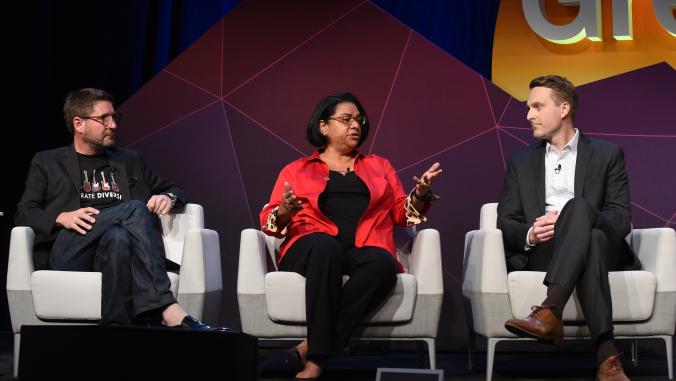This $118 million mutual fund pays companies in carbon credits
Backed by SAP, Danone and Schneider Electric, the new Livelihoods Fund aims to avert the emissions of up to 25 million tons of carbon.

What does the growth of a smallholder milk farm in Kenya have to do with the success of institutional investor SAP?
The Livelihoods Carbon Fund, a newly launched impact investment fund, ties global sustainable economic development to emissions reduction from Danone, SAP, Schneider Electric and five other corporations. Launched Dec. 11 — just before the International Climate Summit in Paris — the fund aims to reach about an $118 million investment in ecosystem restoration, agroforestry and renewable energy projects next year in Africa, Asia and Latin America, which will avoid or sequester up to 25 million tons of CO2 over 20 years.
"The Livelihoods fund creates a link between these worlds," said Bernard Giraud, co-founder of the Livelihood and Danone's former senior sustainability advisor. "Companies invest in the fund, which finances projects that improve the lives of rural communities while mitigating climate change."
What's unique about this mutual fund (which divides risk among several investors) is that dividends are paid out in carbon credits, not cash. Using the principle of additionality — where an investment allows a new sustainability effort to exist — companies can voluntarily offset their greenhouse gas emissions along with their own carbon-reduction efforts while providing resources to vulnerable communities around the world.
The Livelihoods Carbon Fund ties global sustainable economic development to emissions reduction from Danone, SAP, Schneider Electric and five other corporations.
"We already have ($65 million) in investment" from Credit Agricole, Danone, perfume and flavor company Firmenich, Hermès, Michelin, SAP, Schneider Electric and travel agency Voyageurs du Monde, said Giraud, who hopes to inspire other companies to join.
The carbon credits are certified by Gold Standard, established by the World Wildlife Foundation in 2003 to guarantee and benchmark the climate impact of a project and its contribution towards improving the daily lives of local communities and their economy.
The new initiative is the second iteration of a Livelihoods fund launched in 2011 with investments from 10 companies — the eight involved in the recent effort plus La Poste and financier Caisse des Dépôts. That fund reports benefiting 1 million people in developing countries, planted 130 million trees (equivalent to five times the surface area of Paris), equipped 120,000 families with efficient cookstoves and helped sequester 10 million tons of CO2 in projects spanning 10 to 20 years. There is also a fund for sustainable family farming,
"This would be impossible to do if we couldn't pre-finance it," said Giraud. "We had to move millions of young saplings from places where we were collecting the seeds to areas where mangroves were destroyed. We financed this up to ($4.82 million) for the plantation phase."
Growing something great
The fund is built on an innovative business model where investors mutualize investment risks to finance large-scale projects with tangible social and environmental benefits.
"We mutualize the risk to have a broader range of projects," said Giraud. "At the end of the day, each company has a mix of carbon credits. If it's exposed to hurricanes, we have a basket of projects in diversified geographies. They can choose a project that has to do with their own interest."
For example, Danone, which set out to become fully carbon-neutral by 2050, owns a stake in Kenyan processing company Brookside Dairies. The first Livelihoods fund implemented sustainable agricultural practices on Kenya's Mount Elegon, increasing yield while diversifying crops, protecting water resources and preserving the downstream ecosystem of Lake Victoria.
The fund is built on an innovative business model where investors mutualize investment risks to finance large-scale projects with tangible social and environmental benefits.
Due to Brookside's partnership with the Livelihoods Fund, the sale of milk produced by farmers is expected to increase by 20-fold after five years, has affected 180,000 beneficiaries while expanding sustainable farming practices to nearly 62,000 acres and will sequester over 1 million tons of carbon in a decade.
Software solutions company SAP, which has a carbon-neutral goal by 2025, believes that "long-term investment is a perfect fit" for driving efficiency and greenhouse gas (GHG) emissions reduction as well as compensating for emissions, said Global Environmental Manager Marcus Wagner.
The company's emissions mainly result from business operations and travel for its 20,000 consumer-facing employees. From investing in the first Livelihoods Carbon Fund, said Wagner, SAP received credits for about 21,000 tons of CO2 (about 5 percent of its net emissions) in 2016 and will invest $3.62 million in the new carbon fund.
"Investing in version two is a logical consequence, with benefits based on the initial results," he said. "This new project is part of the 'next wave' of carbon projects" with social benefits.
The Livelihoods Fund model is replicable, said Giraud, if there is "patient capital to make a deep transformation, the motivation and engagement of local communities that perceive tangible benefits from the project, a contractual coalition of actors from private, public and civil society with a clear alignment on the expected impacts."
Because SAP sees a positive experience with the carbon offset fund, said Wagner, "we plan to evaluate similar long-term funds."
A web of impact
Each of the fund's projects has multiple benefits. The first fund helped women plant 16 million trees in India's Sundarbans national park near Kolkata. The women were trained by the NGO NEWS to manage the nurseries that strengthen dikes and embankments that protect villages and arable lands from flooding.
The forests also ensure food security and revenues as they harbor crabs, shrimps and mollusks that can be sold in local markets. This project touched 250,000 beneficiaries, restored nearly 111,200 acres of forest and will sequester 750,000 tons of CO2 over two decades.
The fund echoes the aims of the U.N. Sustainable Development Goals (SDGs), a set of interlocking agendas for equitable global growth that ensure the sustainability of the economy, human rights and the environment. In September, Gold Standard launched a label to guarantee that renewable electricity purchases come from updated, efficient power plants and contribute to at least three SDGs, including No. 13 on "climate action."
Similarly, the Livelihoods Fund links poverty reduction and natural resources preservation while helping corporations hit their sustainability mandates.
"We develop models that can turn a vicious cycle into a better cycle," said Giraud.





